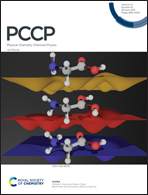Strain-driven phase transition and spin polarization of Re-doped transition-metal dichalcogenides†
Abstract
Two-dimensional transition metal dichalcogenides (TMDCs) are promising in spintronics due to their spin–orbit coupling, but their intrinsic non-magnetic properties limit their further development. Here, we focus on the energy landscapes of TMDC (MX2, M = Mo, W and X = S, Se, Te) monolayers by rhenium (Re) substitution doping under axial strains, which controllably drive 1H ↔ 1Td structural transformations. For both 1H and 1Td phases without strain, Re-doped TMDCs have an n-type character and are non-magnetic, but the tensile strain could effectively induce and modulate the magnetism. Specifically, 1H-Re0.5Mo0.5S2 gets a maximum magnetic moment of 0.69 μB at a 6% uniaxial tensile strain along the armchair direction; along the zigzag direction it exhibits a significant magnetic moment (0.49 μB) at a 2.04% uniaxial tensile strain but then exhibits no magnetism in the range of [5.10%, 7.14%]. By contrast, for 1Td-Re0.5Mo0.5S2 a critical uniaxial tensile strain along the zigzag direction reaches up to ∼9.18%, and a smaller uniaxial tensile strain (∼5.10%) along the zigzag direction is needed to induce the magnetism in 1Td-Re0.5M0.5Te2. The results reveal that the magnetism of Re-doped TMDCs could be effectively induced and modulated by the tensile strain, suggesting that strain engineering could have significant applications in doped TMDCs.



 Please wait while we load your content...
Please wait while we load your content...